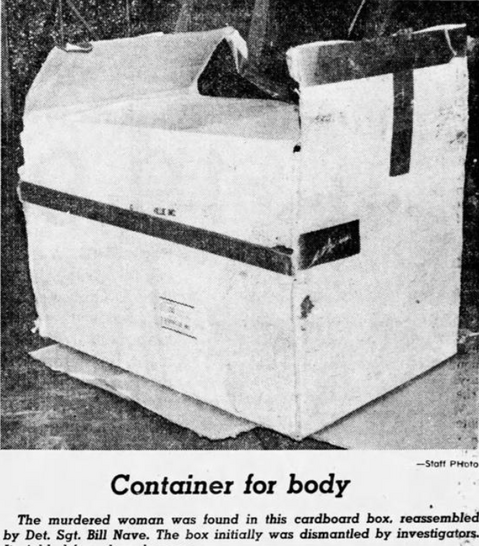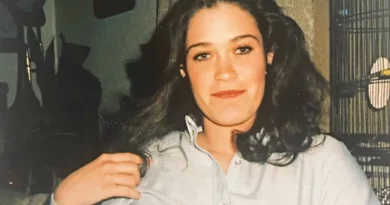Jane Doe Found in the Middle of Cornfield Inside a Cardboard Box in Benton County Indiana
In the quiet farmlands of Benton County, Indiana, a gruesome discovery in 1976 has haunted investigators and locals for decades. A young woman’s body, found in the middle of a cornfield, was abandoned in a large cardboard box, with a gunshot to the back of her head. For over 40 years, this Jane Doe remained unidentified, a symbol of unsolved violence and the enduring mystery of cold cases. Despite numerous attempts to determine her identity and uncover the circumstances of her death, her case remains one of Indiana’s most perplexing unsolved crimes.
The Discovery: Jane Doe Found in a Cornfield
On the morning of October 8, 1976, a farmer in Benton County, Indiana, was tending to his cornfield near a rural stretch of U.S. Route 41, six miles north of Otterbein, Indiana, when he came upon a large cardboard box in the middle of his field. At first, the farmer thought it was just trash left behind, but curiosity drove him to investigate. Inside the box was a shocking and tragic sight—the body of a young woman, left to decay in the middle of the field.
The authorities were quickly alerted, and law enforcement officials arrived at the scene. The cardboard box, which had once been used to ship a refrigerator, now contained the body of a woman who had died from apparent gunshot to the head. The coroner office estimated her remains were left in the field for half a day and she was killed at least a week earlier.
Investigators were immediately struck by the callousness of the crime. The choice to leave her body in a cardboard box in the middle of a rural cornfield suggested an attempt to hide her away from the world, but the discovery sparked one of Indiana’s longest-running cold case investigations.
Initial Investigation: A Search for Clues
Benton County Sheriff’s Office began an investigation into the discovery of Jane Doe with few clues to go on. She was fully clothed, wearing a double knit pants suit with a green two-tone button down jacket and solid green slacks. The Benton County Coroner estimated the woman to be 55-65 years old, 5’2” tall, 160 lbs. with sandy, partially graying hair. She had a large scar due to a right side radical mastectomy. Authorities speculate the box had been in the field only for about 12 hours because it was dry even though it had rained the prior evening. They estimate the woman had been killed about one week prior to being found.
There were no personal items or identification that could help investigators determine who she was. The condition of her body suggested that she had suffered a violent death, with a shot to the head, though the exact circumstances of her death remained unclear.
The cardboard box that contained her body was examined for any trace evidence. Investigators found that it had once been used to transport a refrigerator and bore shipping labels that led them to track its origin. Unfortunately, this lead failed to bring any useful information. Whoever had placed her in the box had gone to great lengths to obscure any connection to her identity.
With no immediate suspects and no one coming forward to report a missing person matching Jane Doe’s description, investigators faced an uphill battle. Missing persons reports from surrounding states were reviewed, but none matched the woman found in Benton County. Despite the wide circulation of information about the case, including sketches and physical descriptions, Jane Doe’s identity remained a mystery.
Clues from the Cardboard Box

The cardboard box that contained the Benton County Jane Doe’s body is one of the most intriguing aspects of this cold case. Measuring about 3 feet by 2 feet by 1 foot, the box was sealed with gray tape and a clothesline, creating an eerie and carefully concealed package. Inside the box was the body of a woman, fully clothed in a green pantsuit, with a gunshot wound to the back of the head.
The origin of the box itself provides some clues. It was traced back to a manufacturer in Melrose Park, Illinois, with boxes of this kind being distributed throughout several Midwestern states, including Indiana. This distribution pattern has made it difficult to determine precisely where it came from, but it suggests that the woman—or at least the box—had connections beyond the local area. The box bore handwritten labels, such as “wardrobe bottom” and “Hall closet,” which hint at it being repurposed from a home or storage during a move.
The condition of the box suggested it had been in the field for only a short time. Despite heavy rains earlier that day, the box was dry, leading investigators to believe it had been placed in the field less than 12 hours before being discovered. This timing raised questions about how the box arrived in such a remote location. Adding to the mystery, there were no visible tracks or drag marks around the box, despite the soft, rain-soaked ground. This absence has led to speculations that the box might have been transported in an unusual manner, such as by a vehicle that did not leave marks or possibly even by air.
Inside the box, alongside the body, was a broken vial of perfume, contributing further to the mystery. The presence of the perfume bottle raises questions about its significance—whether it was an item belonging to the woman or a planted clue by the person who placed her in the box. The detail of the perfume adds to the sense that whoever left the box may have been attempting to obscure or mislead the investigation.
Over the years, forensic analysis of the box has attempted to find clues, including latent fingerprints or other trace evidence, but no clear link has been established. Advances in DNA technology and forensic genealogy have led investigators to revisit the evidence, hoping that new methods might reveal information that could not be detected in the 1970s. The possibility remains that the box might hold traces that could connect it to a specific location or person, even after decades of investigation.
The box, with its mysterious origins and carefully sealed contents, remains a central symbol of the unsolved mystery surrounding Benton County Jane Doe. It represents both the challenges and the hope in unraveling cold cases like this one. The hope persists that new forensic techniques might unlock the secrets hidden within that cardboard container, bringing justice and answers to a case that has puzzled investigators and haunted the local community for nearly 50 years.
Theories & Speculations
Murder and Concealment with Intent to Obscure Identity
- The fact that the woman was shot in the back of the head suggests a targeted and potentially personal motive, typical of execution-style killings. The effort to place her body in a box, tape it shut, and transport it to a remote location indicates a desire to conceal the crime and hinder identification.
- Given that the box was labeled with generic terms like “wardrobe bottom” and “Hall closet,” some speculate that the box was chosen quickly or opportunistically, possibly from a home or storage unit. This might indicate someone close to the woman or a person who had access to her living space.
The Helicopter Theory
- One of the intriguing theories surrounding the Benton County Jane Doe case is that a helicopter may have been used to transport the cardboard box containing her body to the remote cornfield where she was discovered in 1976. The idea arose because of the unusual location of the box—situated deep within a field, far from any visible access points such as roads or trails. Given the secluded nature of the spot, some investigators and locals speculated that whoever placed the box there may have used a helicopter to avoid detection.
- There was no evidence of a path through the field to where she was dumped. There was also an unusual circle of black dirt surrounding the box. Additionally, three people reported seeing a helicopter in the area around the time Jane Doe’s body was dumped. Specifically, it was described as a white and gold 1976 JetRanger Bell. This was a rather expensive helicopter at $160,000 in 1976, which is around $760,000 today. This indicates that Jane Doe’s killer(s) were most likely rich.
- The theory suggests that the box was dropped from the air to minimize leaving evidence such as tire tracks or footprints that would typically be found in such a remote area. Helicopters, though less commonly associated with criminal activity, have occasionally been linked to covert operations due to their ability to reach hard-to-access places quickly and discreetly.
- However, this theory has remained speculative, as no concrete evidence, such as flight logs or eyewitness reports of a helicopter in the cornfield, has surfaced to support it. Moreover, some investigators argue that it is more likely the box was transported to the field by more conventional means, given the lack of advanced resources typically available to individuals involved in such crimes.
- While the helicopter theory adds a layer of mystery to the Benton County Jane Doe case, the current Benton county coroner, Matt Rosenbarger, stated that the helicopter theory is one that they are moving away from as they don’t believe a helicopter played a part in Jane Doe’s death or disposal.
Links to Domestic Violence or Organized Crime
- Some theories propose that the Benton County Jane Doe could have been a victim of domestic violence or involved in an organized crime scenario. The precise nature of the wound and the remote placement of her body could suggest that someone with experience in evading law enforcement was involved.
- The advanced age of the woman (55-65 years) has led to speculations that she might have been connected to someone in the criminal world as an associate or informant. Alternatively, she may have had information that posed a threat to someone, leading to her murder and efforts to keep her identity hidden.
Possible Involvement in a Larger Disappearance or Trafficking Network
- There are speculations that she could have been involved in a broader network of disappearances, possibly even trafficking. Although there is no direct evidence to suggest this, the anonymous nature of her death and the manner of disposal resemble certain unsolved cases across state lines during that era.
- The distribution pattern of the cardboard box, which could have come from anywhere in the Midwest, further fuels theories that her death might be connected to interstate criminal activities.
A Stranger Killing or Random Act of Violence
- Another theory posits that the Benton County Jane Doe may have been a transient individual or a stranger passing through the area, making her a target of opportunity for an unknown assailant. This could explain why no one in the local area reported her missing and why efforts to match her with missing persons from nearby regions have proven difficult.
- The presence of a broken vial of perfume found near the body hints at the possibility that her killer may have planted misleading items to throw off investigators or that there was a struggle.
The Mastectomy Clue: Potential Medical Connection
- The woman’s mastectomy scar has led to speculation that she may have been treated for cancer or had connections to medical facilities, potentially providing a clue to her identity. Some theorists believe that if her medical history could be tracked down through older hospital records, it might offer a lead.
- Her scar leads to speculation that it’s a medical procedure gone wrong and her body was disposed to cover up what really happened. It’s speculated that it could’ve been a hospital cover up or a independent medical organization that may have accidentally killed the victim, and the shot in the head is a cover up. This also might explain the helicopter theory, since many medical facilities use helicopters, mostly for rescue missions.
Involvement of Someone Close: Family or Acquaintance
- Considering that the box seemed to have been sealed carefully and that the body was disposed of in a relatively remote area, some speculate that the killer might have known her personally. This theory suggests that the perpetrator might have had access to her belongings and could have intentionally avoided leaving clues that could link back to them.
DNA Breakthroughs and False Leads
- Despite renewed efforts through DNA testing and genetic genealogy, no conclusive identity has been established yet. The mystery surrounding her identity has given rise to theories that perhaps she was not from Indiana or even neighboring states, but might have been brought from further away. This could explain why no match has been found in local or national databases.
These theories reflect the deep mystery of the Benton County Jane Doe case and the speculation that surrounds unsolved crimes. While advances in forensic science, such as genetic genealogy, have provided some hope, the lack of a definitive narrative means that theories continue to circulate. Each aspect—from the method of transport to the motive for the crime—leaves room for interpretation and the possibility of new revelations in this nearly 50-year-old cold case.
Challenges in Solving the Case: A Cold Trail
As the investigation progressed through the summer of 1976, law enforcement agencies across Indiana and nearby states worked together to try to solve the case. The Benton County Sheriff’s Office enlisted the help of the FBI, local media, and community leaders to raise awareness and ask the public for tips. Unfortunately, despite their efforts, very little new information came in.
Investigators began to consider whether Jane Doe was from outside Indiana, possibly from a distant state or even another country, further complicating the search for her identity. Without a known place of origin, tracking her last known movements or identifying her social circles became nearly impossible.
Additionally, forensic technology in the 1970s was limited. DNA analysis, which would become a critical tool in solving cold cases decades later, was not yet available. Investigators relied heavily on fingerprinting, dental records, and other physical identifiers, but Jane Doe’s decomposition made it difficult to obtain usable samples for comparison.
The public’s interest in the case began to fade as the months went by, and without new leads, the investigation grew cold. Jane Doe was buried in an unmarked grave, her identity unknown, her case a haunting reminder of the fragility of life and the brutal reality of unsolved violence.
The Impact of Jane Doe’s Case on the Community
For the residents of Benton County, the discovery of Jane Doe became a defining moment in the history of their small, rural community. Benton County, a peaceful farming area with tight-knit families and a slower pace of life, was shaken by the revelation that such a violent crime could occur in their backyard. The mystery of Jane Doe’s identity became a point of intrigue and sadness for locals, many of whom still remember the chilling news reports from 1976.
Local law enforcement, too, was profoundly impacted by the case. The officers who first responded to the discovery and the investigators who worked the case for years would recount the story as one of the most difficult and haunting of their careers. Even as decades passed, the Benton County Sheriff’s Office continued to hold onto the hope that one day, Jane Doe’s identity would be discovered, and her family would receive the closure they deserved.
The Role of Forensic Advancements: Renewed Hope in the Case
In the decades following the discovery of Benton County Jane Doe, forensic science underwent dramatic advancements that would ultimately offer new hope for solving her case. In the late 1980s and early 1990s, the advent of DNA profiling revolutionized law enforcement’s ability to identify victims and perpetrators in cold cases. Investigators in Benton County began to explore the possibility of exhuming Jane Doe’s remains to obtain DNA samples.
In the early 2000s, investigators took a major step forward by exhuming Jane Doe’s body and collecting samples for DNA analysis. Her profile was uploaded to national databases, and for the first time, investigators had the potential to link her to missing persons cases across the country.
However, the process was not as straightforward as investigators had hoped. At the time, the national DNA databases were still relatively new, and many missing persons cases had not yet been entered. Despite these challenges, Benton County officials held out hope that with continued technological advancements, a breakthrough could eventually be achieved.
Genetic Genealogy: A New Tool for Solving Cold Cases
In the late 2010s, the introduction of genetic genealogy opened a new chapter in cold case investigations. This technique, which involves comparing DNA profiles from crime scenes or unidentified remains to public genealogy databases, had already solved several long-standing cold cases, including the identification of victims who had remained anonymous for decades.
In 2019, Benton County investigators decided to revisit Jane Doe’s case using genetic genealogy. DNA extracted from Jane Doe’s remains was submitted to genealogy databases, allowing forensic genealogists to begin building out potential family connections. These databases, often used by individuals interested in tracing their ancestry, provided a new path forward in identifying the woman in the cardboard box.
By carefully tracing distant relatives and narrowing down family trees, genealogists worked to identify possible connections to Jane Doe. The process was slow, painstaking, and complex, but with each step, investigators came closer to uncovering the truth.
Continuing the Search: The Quest for Answers
As of 2024, Jane Doe’s identity remains unknown, but the advances in genetic genealogy have renewed hope that this 48-year-old mystery may soon be solved. Investigators continue to work closely with forensic genealogists to track down potential family members and piece together Jane Doe’s story.
The use of genetic genealogy has provided a powerful tool for law enforcement in solving cold cases, and Benton County Jane Doe’s case is no exception. Investigators remain optimistic that with ongoing efforts and public assistance, they will one day be able to restore her name and bring justice to her case.
The Jane Doe found in a cardboard box in Benton County serves as a reminder of the many cold cases that remain unsolved across the country. Her story is one of persistence, hope, and the importance of modern forensic science in uncovering the truth. Though it has been more than 40 years since her body was found, the quest for answers continues, and the investigation remains open.
Discover more from City Towner
Subscribe to get the latest posts sent to your email.




